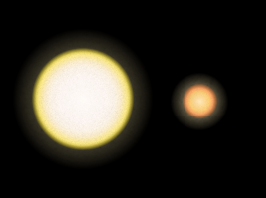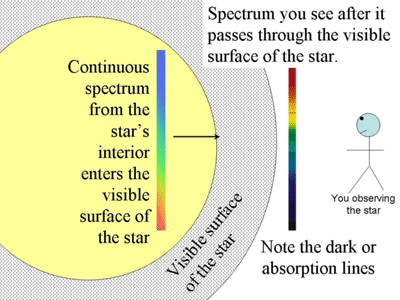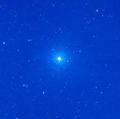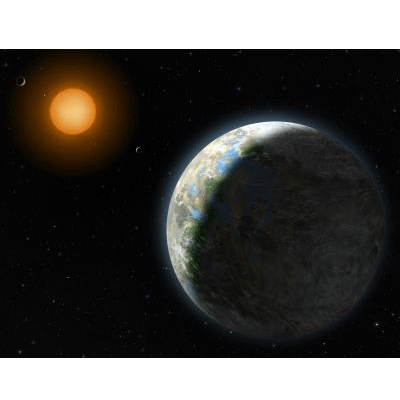Exoplanet Gliese 581g in Goldilocks Zone - just right for life
1-October-2010
Just right for life
It's like the Goldilocks story but without the porridge.
We had planets on both sides of the habitable zone, says astronomer Steven Vogt. "One too hot and one too cold. Now we have one in the middle that is just right."
Just right for life is what he means. In the past 20 years astronomers have found almost 500 planets in orbit around other stars. They call them exoplanets. Most of these are gas giants like Jupiter and Saturn. And none was in the Goldilocks Zone until now. So all were either too close to their star or too far away. Which made them too hot or too cold for life.
But now a team of planet-hunters has discovered a planet roughly the size of Earth (3 or 4 times its mass) right in the middle of the Goldilocks Zone of a star that is not too far from us. Not too far compared to other stars, that is, but still a pretty long way - 20.3 light years, which is 119 thousand billion miles.
The planet is called Gliese 581g. Not a very thrilling name for such an exciting discovery, you might think. But it takes its name from the star - Gliese 581. And the planets of a star get named in the order they are discovered, starting with 'b'.
We already knew Gliese had four planets - Gliese 581b, c, d and e. On 30 September 2010 the Lick-Carnegie Exoplanet Survey announced they had discovered two more - Gliese 581f and Gliese 581g.
Gliese
Gliese 581 might not seem too promising for planets, since it's a red dwarf star. These are smaller and dimmer than our sun. But that just means the Goldilocks Zone - not too hot, not too cold - is closer to it. The new planet Gliese 581g is just 1/7 of the distance from its sun that the Earth is from ours.
The scientists calculate that the mass of the newly discovered planet is three or four times that of the Earth. So that means it is probably a rocky planet with a definite surface. It also means it has enough gravity to hold onto an atmosphere.
Being so close to its sun means it completes an orbit pretty fast. A year on Gliese 581 - the time it takes to orbit its sun - lasts just 37 days.
The planet hunters who discovered the new worlds were led by astronomers Steven Vogt, at the University of California, Santa Cruz and Paul Butler at the Carnegie Institution of Washington. "Our findings offer a very compelling case for a potentially habitable planet," says Vogt.
The findings are reported in a paper to be published in the Astrophysical Journal. They are based on 11 years of observations of the star Gliese 581 using the HIRES spectrometer that Vogt designed. This is attached to the Keck I Telescope in Hawaii.
The spectrometer allows precise measurements of a star's motion along the line of sight from Earth.
Exoplanet hunting
How does that help the team to discover planets? Well gravity works both ways. A star pulls on a planet and keeps it in orbit. But the planet also pulls on the star with exactly the same force. The star moves far less than the planet simply because its mass is much greater. But it does move.
The spectrometer gives astronomers a way to detect that movement. Two pieces of science lie behind this. One is the Doppler effect, which is the scientific name for something very familiar - the way a siren or car engine changes in pitch as it passes your ear.
The reason that happens is this. When something that's making a sound is moving towards you, the sound waves bunch up a little. When it's moving away the sound waves spread out a bit. This actually happens with all kinds of wave. And light is a kind of wave.
So when a star is moving towards us, the light waves from it get bunched up a little. When the star is moving away they spread out a bit.
We can't hear light waves, so this doesn't give a change of pitch. Instead it gives a change of colour. When light waves are bunched up a bit the colour shifts towards the blue end of the rainbow.
When they are spread out the colour shifts towards the red end. That's why the Doppler effect with light is often called the redshift - most things in the universe are moving away from us.
Give us a twirl
The second piece of science we need is that the spectrum from a star - the rainbow you get when the star's light is put through a  spectrometer - has dark bands.
spectrometer - has dark bands.
This is because light of the missing shades of colour, where we see the bands, doesn't escape from the star. Instead it gets absorbed by the material the outer part of the star is made from - mostly hydrogen.
So how does that help astronomers detect planets around other stars? Well, as a planet moves in its orbit around a star, the star moves in the same shape of orbit, but smaller. A lot smaller.
It's like two skaters on ice, a big heavy man and a small light woman, twirling around each other. There's a nice animation here that shows what we're talking about. Notice the motion of the star and how the dark bands shift to the blue as the star is coming towards us, and the red as it's moving away.
This animation is useful but it exaggerates enormously the movement of the star and the relative size of star and planet. So it doesn't show how difficult the job is.
"It's really hard to detect a planet like this," Vogt says. "Every time we measure the radial velocity, that's an evening on the telescope, and it took more than 200 observations to detect this planet."
Aliens?
So if Gliese 581g is habitable, could it be inhabited? Might there be alien life swimming in its seas, if it has any, or flying through its air or walking on its ...
I was going to say 'earth'. But would you still call it earth on a different planet? I suppose you might. 'Walking on its Gliese 581g' doesn't sound right.
Anyway about the aliens, the answer is: we don't know. Yet.
Scientists are working on ways of detecting signs of life by studying the light from stars that have planets. But these need measurements that are very tough to make and can only be done from above Earth's atmosphere. It takes spaceships and instruments made for the job, such as NASA's Terrestrial Planet Finder or ESA's Darwin.
What we can say now, after this discovery, is that the chances are looking good. And not just for Gliese 581g. A relatively small number of stars have been carefully studied by planet hunters. Which means this discovery has come surprisingly quickly.
"If planets in the Goldilocks Zone are really rare, the planet-hunters would almost certainly not have found one so soon and so close," says Vogt.
"The number of systems with potentially habitable planets is probably on the order of 10 or 20%, and when you multiply that by the hundreds of billions of stars in the Milky Way, that's a large number.
"There could be tens of billions of these systems in our galaxy."
More help with words
| attraction | device | electromagnetic waves | frequency | galaxy | gravitation |
| instrument | journal | mass | orbit | radiation | vibration |
For other websites and resources relevant to this science story try the


